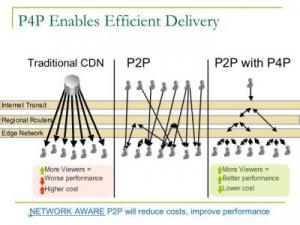by:Jason Mick

In a traditional CDN network data can only go from a central location. P2P has speeded up file transfers by allowing users to shuffle data, but its still inefficient. The new P4P technology will make communication more direct, resulting in cost savings and higher speed. (Source: Doug Pasko and Laird Popkin)
As if P2P wasn't bad enough, now researchers have come up with a more efficient way to fileshare
The international community may be preparing to launch the Anti-Counterfeiting Trade Agreement (ACTA) which will force ISPs to log filesharing and hand over user records to the government, will eliminate privacy tools, and allow ex parte border searches, but there is some good news on the horizon. Researchers at Yale have come up with a breakthrough in file sharing technology. The new system coordinates Internet Service Providers (ISPs) and Peer-to-Peer (P2P) software providers to raise internet efficiency, and perhaps file transfer speeds.
Changes in internet usage over the last 10 years have put a severe strain on the world's computers, causing them to run less efficiently and putting stress on overall internet bandwidth. In 1998, P2P traffic accounted for only 10 percent of the total traffic on an average network. Today it accounts for as much as 70 percent. Web browsing, which once accounted for 60 percent of traffic has fallen to 20 percent, email from 10 percent down to 5 percent.
Professors Avi Silberschatz, Y. Richard Yang, and Ph.D. candidate Haiyong Xie, faculty members at Yale's Department of Computer Science, are developing a new proposed standard known as P4P. P4P stands for “provider portal for P2P applications”. The system would make for more explicit and uninterrupted communications between ISPs and P2P applications.
The team will be presenting their findings in a paper at the premier Seattle computer networking class ACM SIGCOMM 2008 in August. In the paper, they detail how P4P will reduce cost for ISPs and improve P2P performance for normal users. Silberschatz explains -- current P2P technologies do not have a sense of what network they're on and may do ridiculous things like making a long distance call to connect to a neighbor when transferring a file. The lack of intelligence translates in money lost for the ISPs, particularly for users with "unlimited" connections, and in time lost for the consumer, who could be receiving the file faster.
The Yale team hasn't just come up with a name for and analysis of the new architecture; they also are testing and implementing key system components. Yang states, "Right now the ISPs and P2P companies are dancing with the problem — but stepping on each other’s toes. Our objective is to have an open architecture that any ISP and any P2P can participate in. Yale has facilitated this project behind the scenes and without direct financial interest through a working group called P4P that was formed in July 2007 to prompt collaboration on the project."
The working group used is hosted by DCIA [Distributed Computing Industry Association]. It is co-chaired by Doug Pasko from Verizon and Laird Popkin from Pando. Over 50 major organizations are aboard the project. Silberschatz says the new technology has the power to greatly improve the internet. He comments, "The P4P architecture extends the Internet architecture by providing servers, called iTrackers, to each ISP. The servers provide portals to the operation of ISP networks."
The new system is a multi-mode network -- In the most basic mode it simply reroutes traffic to avoid "hot spots". In a more complex mode it trades traffic between ISPs to create the most efficient traffic and cost flow. This will lower load on sites and lower overall operating costs.
Should ISPs be scared of losing their independence? Not so says Silberschatz. He states, "While ISPs like AT&T, Comcast, Telephonica and Verizon and the P2P software companies like Pando each maintains its independence, the value of the P4P architecture is significant, as demonstrated in recent field tests."
In a recent test using the new P4P system in a field test with Pando software in March 2008 reduced inter-ISP traffic by an average of 34 percent. Better yet it increased the download speeds by 235 percent within the U.S. and 898 percent internationally.
Some might fear privacy ramifications of increased ISP involvement with P2P traffic. This is possible, but unlikely as ISPs already carry all the P2P traffic and can elect to monitor it at any time as is. Rather the new system will merely help to save money and save time for everyone involved. About the only people who perhaps should be concerned with this development are the recording industry's legal teams; with P4P possibly powering downloads within a few years, many more years may quickly become the "Year of the Pirate".
